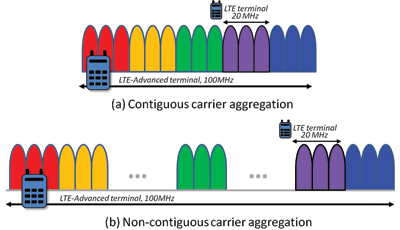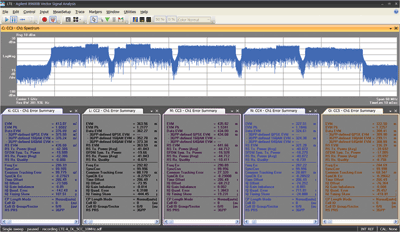The evolved version of LTE adds performance enhancements that will present complex and daunting test challenges
BY JUNG-IK SUH
Wireless Marketing Program Lead Electronic Measurement Group
Agilent Technologies
www.agilent.com
Even as the first deployments of LTE capture widespread public attention, the LTE standard is evolving. In December 2010, LTE-Advanced was introduced in Release 10 of the 3GPP specifications. This evolved version adds performance enhancements such as a 1 Gbit/s peak data rate to meet ITU requirements for the IMT-Advanced 4G radio-communication standard.
Today’s LTE (3GPP Release 8) achieves its speed and performance using a mix of technologies that includes multiple channel bandwidths, different downlink and uplink transmission schemes, two transmission modes (FDD and TDD), and MIMO. LTE-Advanced aims to improve peak and average data rates and uplink spectral efficiency by adding three new features: carrier aggregation, an enhanced uplink, and enhanced multiple antenna transmission (advanced MIMO). With the additional requirement that LTE and LTE-Advanced coexist and interwork with older 2G/3G systems, the design and test challenges are complex and daunting.
Table 1 compares peak data rate and peak spectral efficiency targets for LTE, LTE-Advanced, and IMT-Advanced. A 1-Gbit/s peak downlink data rate is required for IMT-Advanced and will be achieved in LTE-Advanced using 4 x 4 MIMO and transmission bandwidths wider than approximately 70 MHz. In terms of peak spectral efficiency, Release 8 LTE satisfies the ITU’s 4G requirement for the downlink though not for the uplink. The peak spectral efficiency targets for LTE-Advanced are substantially higher than ITU requirements. Note that improving average spectral efficiency and cell-edge performance will be more challenging, and in these areas LTE-Advanced targets (not shown) are much closer to those of IMT-Advanced.

LTE frequency bands are release-independent features, which means operators can deploy an LTE device in a band added to a later release of the specification. Potential performance issues include the overlap that exists between some LTE bands for regional reasons. Also, the gap between a band’s uplink and downlink ranges in some case is quite narrow, making filter design more difficult.
Carrier aggregation
LTE currently supports channel bandwidths up to 20 MHz. To achieve significantly higher data rates as specified in LTE-Advanced, channel bandwidth size must be increased. IMT-Advanced sets the upper limit at 100 MHz, with 40 MHz the expected minimum. Because large amounts of contiguous spectrum are not available to most operators, the ITU allows the creation of wider bandwidths through aggregation of contiguous and noncontiguous component carriers (see Fig. 1 ). Thus spectrum from one band can be added to spectrum from another band in user equipment that supports multiple transceivers.

Fig. 1: The concept of contiguous and non-contiguous carrier aggregation illustrated here contrasts the bandwidth support requirements of the LTE and LTE-Advanced user equipment.
Carrier aggregation will undoubtedly pose major difficulties for LTE-Advanced user equipment, which must handle multiple simultaneous transmit and receive chains. The use of simultaneous, non-contiguous transmitters will create a highly challenging radio environment in terms of spur management and self-blocking. And simultaneous transmit or receive with mandatory MIMO support will add significantly to the challenge of antenna design. Some of the key LTE test specifications must be redefined for the LTE-Advanced multicarrier signals. Examples are error vector magnitude (EVM) and in-band emissions.
Enhanced uplink
Today’s LTE uplink is based on single-carrier frequency division multiplexing (SC-FDMA), a powerful technology that combines many of the flexible aspects of orthogonal frequency division multiplexing (OFDM) with the low peak-to-average power ratio (PAPR) of a single-carrier system. However, SC-FDMA allocates carriers across a contiguous block of spectrum, which limits scheduling flexibility. LTE-Advanced introduces clustered SC-FDMA in the uplink, allowing frequency-selective scheduling of component carriers for better link performance. Also, the PUCCH and PUSCH can be scheduled together to reduce latency.
Clustered SC-FDMA will help satisfy uplink spectral efficiency requirements while maintaining backward compatibility with today’s LTE. It does increase PAPR, which can lead to transmitter linearity issues, and use of simultaneous PUCCH and PUSCH also increases PAPR. Further, the presence of multicarrier signals increases the opportunity for in-channel and adjacent-channel spur generation.
Enhanced multi-antenna transmission
In LTE-Advanced the specified number of data streams (and, correspondingly, antennas) is increased. Up to eight transmitters in the downlink (with the requisite eight receivers in the UE) will enable 8×8 single-user MIMO. The UE will support up to four transmitters, allowing 4×4 transmission in the uplink when combined with four receivers in the base station. Gains are expected not just in peak data rate but spectral efficiency, cell-edge performance, and coverage.
Initially LTE-Advanced is focused on downlink beamsteering with up to 4×2 antenna configuration. This provides the advantages of multiple transmitter diversity while limiting the number of receivers required in the UE.
MIMO increases the number of antennas in the system, and MIMO antennas have to be de-correlated. A major challenge will be designing multiband MIMO antennas with good de-correlation to operate in the small space of an LTE-Advanced UE. New methods are required for predicting actual radiated performance of an advanced MIMO terminal in an operational network, so 3GPP is considering ways to extend MIMO over the air (OTA) testing for LTE-Advanced.
PHY layer challenges
LTE’s variable and wide-channel bandwidths and variable modulation formats and sequences increase the system’s flexibility and capability. They also present numerous, complex transmitter and receiver configurations for performance testing.
The use of multiple antenna techniques and OFDMA to support high data rates adds further complication, and SC-FDMA in the uplink creates test challenges unique to LTE. With performance targets for LTE set exceptionally high, engineers have to make careful design tradeoffs to cover each critical part of the transmit and receive chain. Other challenges are associated generally with performance of the physical layer, including such impairments as nonlinearities and noise figure in RF up-converters and down-converters, phase and amplitude distortion from power amplifiers, and channel impairments such as multipath and fading. And not the least of all these challenges is the fact that LTE is a new technology, still open to change and interpretation.
LTE-Advanced retains all this complexity and adds more. Although LTE-Advanced test requirements are still being discussed in 3GPP, it’s expected that they will reuse current LTE test specifications as much as possible. For example, current LTE requirements for transmitted signal quality tests (frequency error, EVM, DL RS power) will be applied for each component carrier in a multicarrier signal. A time alignment error between component carriers is under consideration, and operating band unwanted emission requirements for carrier aggregation transmissions are being aligned with existing definitions for LTE Release 8 multicarrier base stations.
With the publication of the LTE-Advanced specifications, product developers can investigate new performance features, prompting test vendors to enhance their products with new measurement capability. Agilent’s LTE-Advanced library, for example, has been enhanced for developers, enabling them to explore working 8×8 MIMO LTE-Advanced reference designs built from a comprehensive library of over 170 baseband models and test benches. System and algorithm developers can test new designs against the standard, downloading test vectors directly to instruments for early and continuous hardware validation.
Software, such as Agilent Signal Studio and Vector Signal Analysis, can support generation and analysis of LTE-Advanced standard-compliant signals for the next wave of development. Design engineers can fully characterize single or up to five aggregated component carriers simultaneously, setting the parameters and viewing the measurements on each (see Fig. 2 ).

Fig. 2: The ability to fully characterize up to five component carriers simultaneously setting up and viewing different measurements on each helps simplify the task of testing LTE-Advanced.
In the enhanced uplink, engineers can generate and analyze clustered SC-FDMA and simultaneous control (PUCCH) and data (PUSCH) transmission. With these capabilities, they can begin testing the physical layer implementations of LTE-Advanced in their devices today. As LTE-Advanced moves through the technology lifecycle, measurement tools will continue to evolve with new capabilities added for conformance, manufacturing, and deployment test. ■
Advertisement
Learn more about Agilent Technologies





